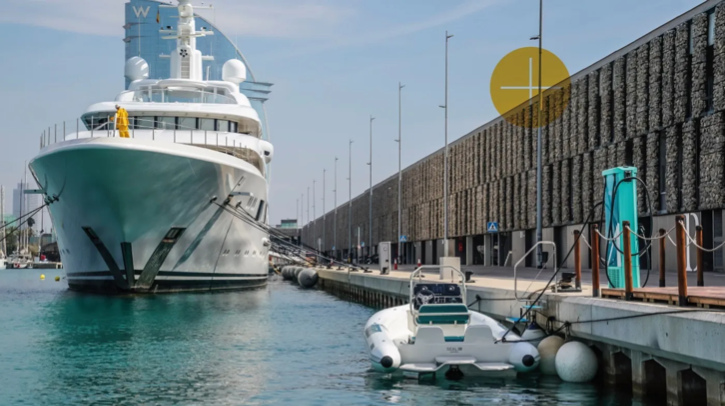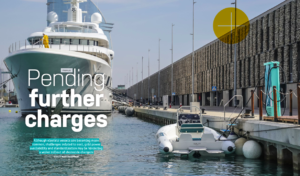Electric vessel propulsion has come a long way since its first tentative applications. However, although there is growing interest and investment in pure and hybrid electric vessel operations, the shoreside charging infrastructure required to top up ships’ onboard battery packs is not yet as widespread or standardized as it is for electric cars and trucks.

Power availability
Although Munn and Khan are optimistic that the shoreside charging infrastructure will evolve to serve this burgeoning green vessel market, both identify several hurdles that the industry must overcome before electric powertrains become the norm.
“The biggest challenge is availability of power at ports and marinas,” says Khan. “Unlike inland locations, where there are ample options to secure a grid connection, ports and marinas – by their very nature, being near the sea – are at the end of a supply branch for electrical connections.” Additionally, Khan says, the associated costs of upgrading the electrical distribution infrastructure can quite quickly become unfeasible.
Munn also identifies availability of power from the grid as an obstacle. “As soon as you go above anything like a leisure vessel, the demand for charging becomes quite high,” he says. “A lot will obviously depend on each vessel’s profile and power requirement and whether it needs to charge between each trip or can do so overnight, when the operator has a bit more time – but some of the charging connections are quite power-hungry.”

Fortunately, Munn and Khan say advances in clean-energy tech mean that there are a few options to augment existing shore power in a demonstrably green manner. For example, Munn says, “You could have a self-contained solar panel farm or a shore-based/floating wind turbine charging a battery; then you take the battery out and use it to charge the vessel.” Marine Zero is currently working alongside UK Power Networks and LCP Delta on the Electric Thames project, which is assessing the viability of using battery-powered vessels to capture and store green energy from the sun and wind, and feed it back to the grid during peak electricity hours to bolster the energy capacity of the local grid.
Khan adds that Aqua SuperPower is developing smaller-scale “battery-backed buffer solutions” that can connect a relatively small power grid or local site to a storage battery. Then, the battery can be used to quickly charge electric boats using high-power DC charging (CCS) technology. “Alternative low-carbon fuels such as hydrogen can be used to generate electricity via a fuel cell, then bunker said electricity into grid-scale batteries so that instant vessel power demands can be met.”
“Unlike inland locations, ports and marinas – by their very nature – are at the end of a supply branch for electrical connections”
Husnain Khan, Aqua SuperPower
Aqua SuperPower is the project partner for Thames Clippers’ successful entry in the UK Department for Transport’s Zero Emission Vessel and Infrastructure (ZEVI) competition. As a result, the group will supply the charging infrastructure for a 40m, all-electric freight catamaran operating between Dartford in Kent and Tower Bridge in London: a 55-minute trip at a speed of 22kts. In the central London location, and due to grid and space constraints for infrastructure, Aqua SuperPower will deploy a 2MW floating battery barge with high-power DC outputs, capable of bringing the vessel back up to 80% charge in 30 minutes. “The Dartford location will employ a more traditional scheme, as there is grid availability and space for a substation and energy rectification compound – also charging at up to 2MW speeds,” says Khan.

Of course, adding fixed and floating solar panels and wind turbines to port infrastructures doesn’t come cheap. However, as Khan points out, such developments are being backed by subsidies such as the UK’s DfT CMDC and ZEVI initiatives. The UK government has also been trying to encourage green energy production through its Renewable Energy Guarantees of Origin (REGO) scheme, which issues certificates, called REGOs, to projects that have managed to generate electricity from renewable sources. EU member states have a similar initiative in place, called Guarantees of Origin (GoOs).
Charger standards
Another challenge facing charger network developers is standardization. To date, CCS connectors have become the standard for electric vessel charging, having been successfully proved in the automotive sector. “Aqua SuperPower can charge any vessel that employs the CCS charging standard,” Khan says. This standard is best-suited to vessels around 50-60m in length, he adds, but is not appropriate for larger-scale, oceangoing ships.
The answer for these larger vessels could come in the form of chargers developed to the megawatt charging system (MCS) standard – one example being the megawatt charger for trucks and vessels launched by Shell in June this year. That MCS is connected to the grid at Shell’s Energy Transition Campus Amsterdam (ETCA) facility, which draws on 3,600 rooftop solar panels, a hydrogen electrolyzer and stationary battery storage to produce clean electricity for the charger.

“There’s still a lot to look at in that standard, including the risk of the vessel drifting away while it’s connected,” Munn says. The industry will have to consider such maritime-specific scenarios when taking MCS technology to the next level, rather than simply “importing charging solutions from the automotive sector into a marine environment”, he says.

Khan agrees the MCS standard has room for improvement, especially when it comes to the availability of corresponding equipment for the vessels. “The charger OEMs may well be producing MCS chargers, but more needs to be done on the vessel/vehicle receptacle side as well as supporting interfaces like the charge control units,” he says. The communication protocol between the charger and the electric vessel – known as the ‘handshake’ part of the charging process – ensures that charging is conducted safely, drawing on an exchange of information related to the battery’s power level, temperature and charging status. “There are still developments required related to the handshake when using the MCS standard, which differ from the better-known, established and supported CCS protocol,” Khan says.
“As soon as you go above anything like a leisure vessel, the demand for charging becomes quite high.”
Tim Munn, Marine Zero
The required evolution of MCS technology will largely depend on a coordinated industry effort, through associations such as ZESTAs as well as the CharIN project, which has attracted more than 300 globally based partners to push the development and adoption of safe, efficient charging standards.
Munn adds, “We’re aware that training competency is often overlooked; it’s an area we have invested in to support the transition. We have developed specialist competency frameworks to ensure operators have the right skills to manage modern electrical systems and shore-based charging equipment and safety.
“This shift in the operational mindset will become more pressing as once-a-week bunkering becomes daily or more frequent charging and crews move away from operating diesel marine engines.” Ensuring the safety of personnel and equipment during charging is crucial, given the high power levels of MCS chargers and the increased risk of damage to infrastructure should something go wrong.
Capex conundrum
While government subsidies for electric vessel charging schemes are to be welcomed, it’s worth noting that there is only so much money to go around. Cost will be a key challenge to the further expansion of shoreside charging infrastructure, and will have a decisive impact on which projects go ahead.
“We could get to the stage where the cost of electricity becomes similar to that of diesel,” says Munn. “But the initial capex investment in the charging infrastructure is always going to be high. Going green inevitably means a cost premium, and that’s a challenge for some ferry companies that operate with low margins.”
Marine Zero’s answer is to cover some of these up-front costs, enabling operators and end users to access electric power without breaking the bank. “We can pay the capex, then finance it back to the vessel owners and operators so they pay for the energy that’s consumed while charging,” Munn says. This has helped kick-start several projects in the UK and Europe, and Marine Zero is drafting plans for expansion overseas – particularly in territories where the initial capex cost may be a significant barrier to fleet electrification.
This article was originally published in the September 2024 issue of Electric and Hybrid Marine Technology. To view the magazine in full, click here.




